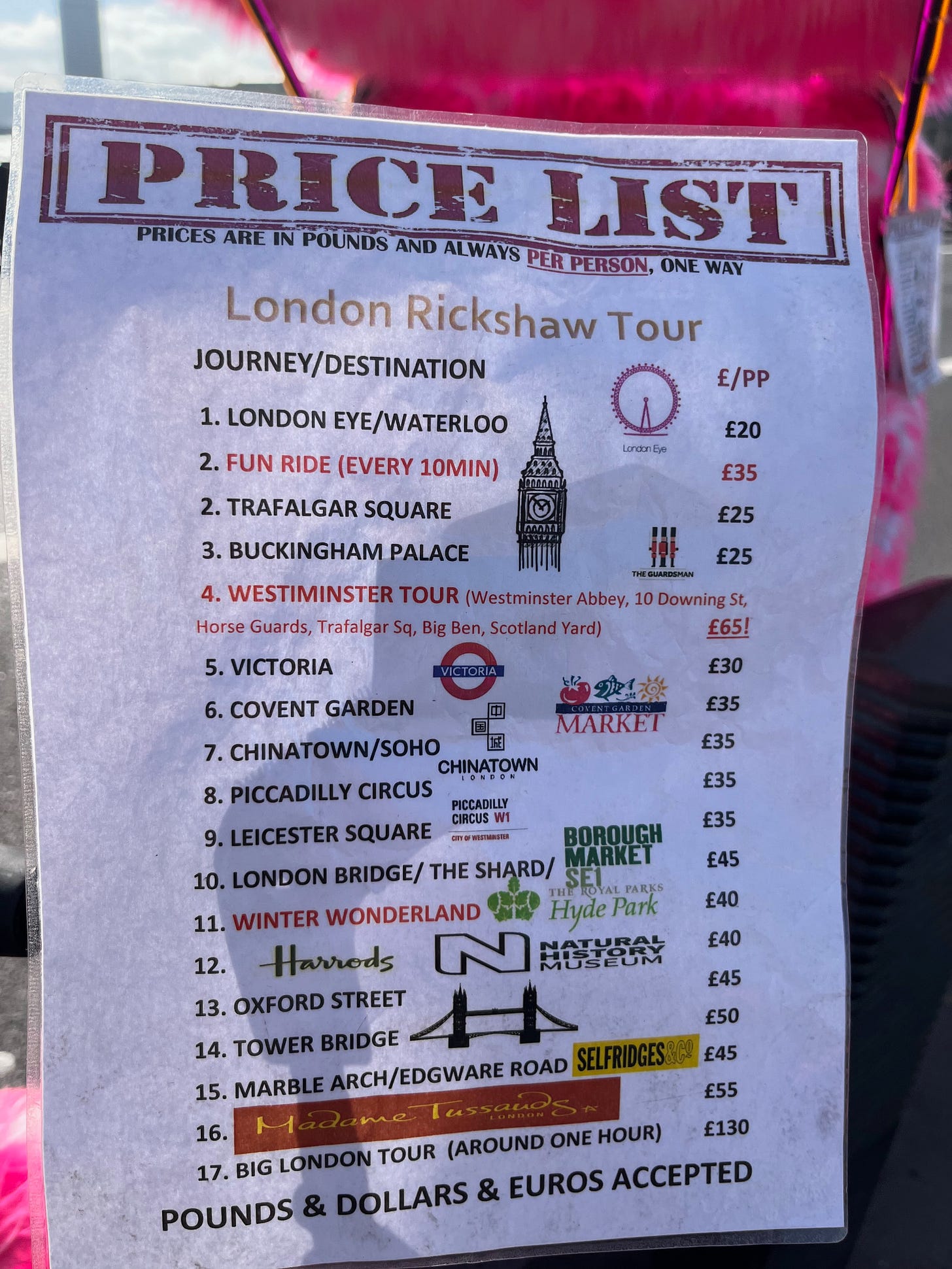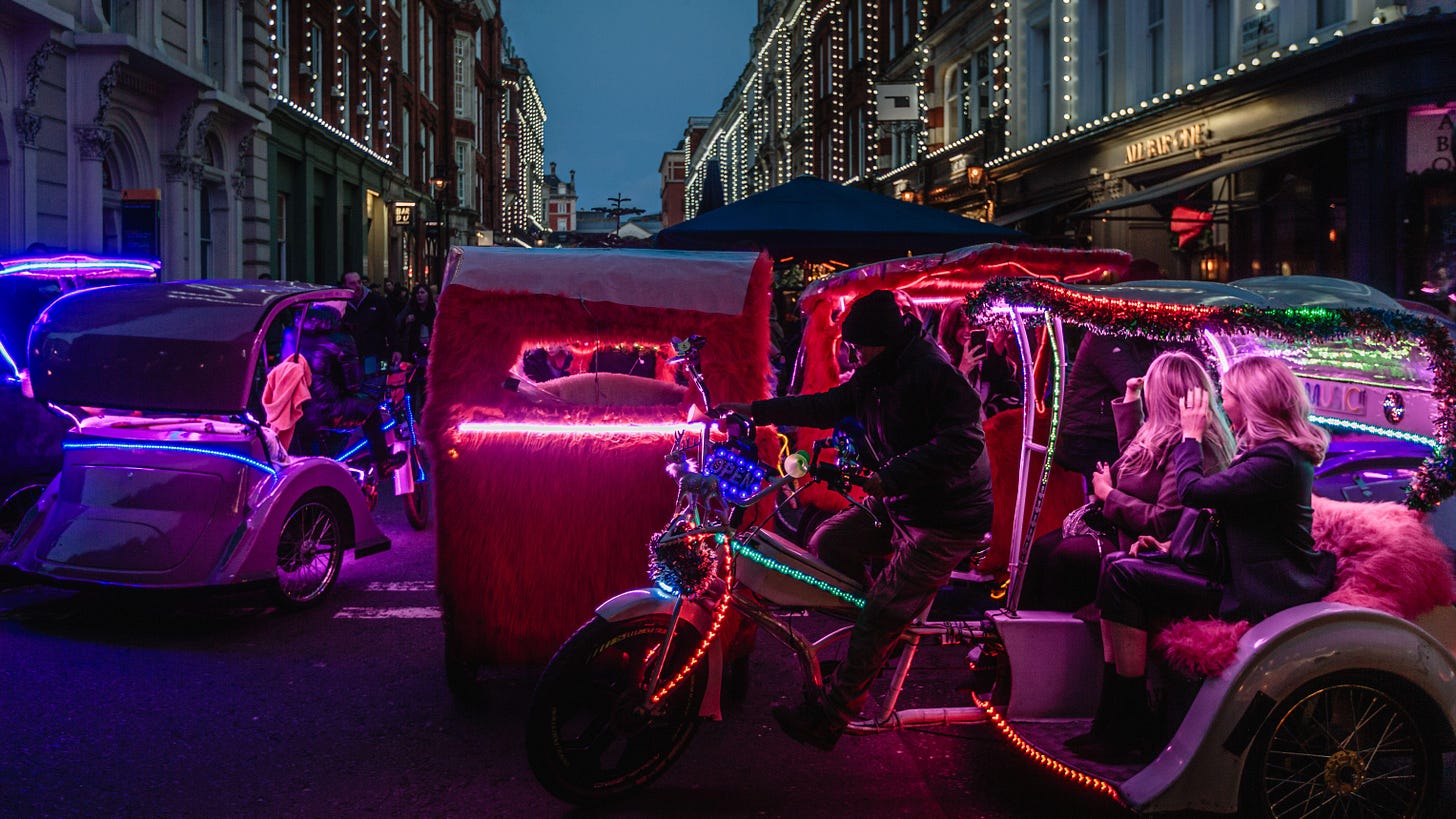London’s Pedicabs: Sex, loathing, and highway robbery
The inside story of how the capital's most chaotic and least understood form of transport actually works.
By Jim Waterson, Rachel Rees, and Cosmic Thapa
What’s the most publicly embarrassing way you could die?
London Centric pondered this last month while sitting in the back of a pedicab as it jumped several red lights and bombed across Trafalgar Square at full speed with Sabrina Carpenter’s “Espresso” playing from its speakers. After narrowly avoiding being shunted by a furious black cab during our uninsured ride past Nelson’s Column, we headed on towards parliament.
Once there, the driver of an open-top Big Bus Tour blocked our progress and wound his window down to scream “you’re a fucking menace” at us. Having given as good as he got in response, our pedicab driver finished the journey, just about intact, on Westminster Bridge. He parked up the tricycle next to a group of police officers who were distracted by the Sisyphean task of moving on yet another illegally-parked ice cream van operated by south London’s notorious Sanli family.
The ride from Leicester Square, close to where a pedicab was recently videoed in flames after its battery exploded, to Westminster Bridge took 11 minutes. We were charged the agreed fare of £50, a sum that our driver dismissed as “fucking peanuts” but made no attempt to inflate. Several road traffic offences were committed during our brief journey, but it was exhilarating — the equivalent of taking a rollercoaster ride at a decaying theme park where you’re not quite sure if a bolt will come loose at a crucial moment.
If Transport for London can come up with a suitable set of regulations, the capital could be experiencing the final months of the lawless and entirely unregulated pedicab trade, bringing an end to the sight of hundreds of electrically-assisted rickshaws covered in furry material and neon lights trying to pick up tourists in central London. As with any change like this, there’s going to be some people who make big money out of it — and some who lose out.
“If I don’t rip people off and can still make £50,000 then it’s safe to assume how much tax they’re not paying”
After spending months immersed in the capital’s pedicab industry, London Centric has come to one overriding conclusion: There is no one who hates London pedicab drivers more than other London pedicab drivers. John, a longstanding driver from Turkey, accused his rivals of engaging in tax fraud and of delivering customers to brothels. Remy, a driver originally from Jamaica, made a number of claims about his rivals adding a zero when entering payments on their card machines in order to overcharge rich Middle Eastern customers on their way to Selfridges. Adam, whose British-Algerian family own a number of the bikes, accused other operators of skimping on safety measures which have seen pedicabs go up in flames, while also flooding the market with new drivers from Bangladesh. Tensions between riders of different ethnic backgrounds are rife, with accusations sometimes tipping over into outright racism.
Almost all the drivers say they want Transport for London to regulate the industry — but mainly because they believe the main benefit would be regulating their rival drivers out of existence and boosting their own profits.
“All their bikes are illegal, it’s all corrupt, no one cares about it,” claimed John, as he set off on another shift. He told stories of rival drivers charging £300 for a journey from Covent Garden to Oxford Street, of some drinking on the job, and of pedicabs with illegally powerful electric motors used to deliver customers to strip clubs.

John insists he plays by the books, doesn’t overcharge customers and pays his taxes. He said he once calculated that the tax paid by London’s 300-plus pedicab drivers should be in the millions of pounds: “My revenue is around £50,000 [a year]. If I don’t rip people off and can still make £50,000 then it’s safe to assume how much tax they’re not paying.”
He said he had even taken to contacting the authorities when he sees tourists overcharged by fellow drivers: “Sometimes when they reach their destination the bill is 300, 400, 500 pounds, and if you don’t pay it, they threaten you, they won't let you get off. I see it in Oxford Street.”
In one particular case he passed the details of a ripped-off customer, a crime number and the name of a driver to the authorities. He constantly expresses astonishment about the lack of law enforcement in the capital: “Nothing happens, my friend. Nothing ever happens! Nothing!”
A short history of stagecoaches, from Dick Turpin to Sabrina Carpenter.
The modern music-blaring neon-light-covered electric-powered London pedicab you see on the streets of the capital exists entirely thanks to a loophole accidentally established by the Victorian members of parliament who wrote an 1869 law designed to govern horse-drawn vehicles.
The Metropolitan Public Carriage Act, passed before the invention of either the modern safety bicycle or the motor car, defined two forms of vehicles which could “ply for hire" and pick up passengers at the sides of the capital’s roads. There was the hackney carriage (a horse-drawn vehicle rented in its entirety, now used as the basis of the definition for the motorised black cab) and the “stage carriage” (where someone rents a single seat in a horse-drawn carriage and each passenger is charged a separate fare).
With the arrival of motorised vehicles and the establishment of a proper public transport network, the law regulating “stage carriages” — a term then used interchangeably with the word “stagecoach” — became an irrelevant quirk of history, mainly associated with a form of transport targeted by highwaymen such as Dick Turpin.
That was until the London pedicab industry began in 1998. A company called BugBugs started putting human-powered rickshaws on London’s streets in an attempt to create a quirky, environmentally friendly method of transport. Black cab drivers hated the new rickshaws, viewing them as both a threat to their monopoly right to pick up passengers at the side of the road and a menace on the capital’s streets.
The London Taxi Drivers Association brought a private prosecution against BugBugs in 2003, alleging the pedicabs were unlicensed hackney carriages and should be banned.
To almost everyone’s surprise, a high court judge disagreed. Mr Justice Pitchford ruled that, within the boundaries of London, pedicabs are not “hackney carriages” but “stage carriages”, on the condition that passengers pay a fare calculated on a per passenger basis.

Back in 2003 the judge accepted that an “unwelcome consequence” of his ruling was that pedicabs were not regulated in Greater London (separate laws apply elsewhere in the UK) but he expected it would take a “few months” to fix the outstanding issues. Instead, Transport for London and successive governments have spent more than two decades trying to find a way to negate the judge’s ruling through fresh parliamentary legislation and the introduction of a system of formal regulation.
In the meantime, just like the historic stagecoaches of popular imagination, the noisy London pedicabs that are their legal successors have often been accused of leaving passengers as the victims of highway robbery.
Got a story that needs looking into? Get in touch with London Centric over email or WhatsApp.
“They’ll add another zero”
TikTok and Instagram are full of videos of tourists being ripped off by pedicab drivers, from a group of American women being charged £200 for a five minute journey in Mayfair, despite the driver’s initial promise that the journey would cost under £80, to a pedicab driver telling a man that the fare would be £5 per minute, totalling more than £200.
In a 2023 complaint to TfL, one pedicab customer said they were “swindled” with an extortionate £1,278.96 fare from Westminster Abbey to Buckingham Palace. Other complaints described fares that were ten times what drivers claimed – £336 instead of £36.60, or £94.40 instead of £9.40 – with passengers only realising when they checked their bank statements after paying.
"This was the first time we have been so obviously cheated in London, a city we have grown to love and feel safe in", one tourist wrote.
Many of the pedicab drivers who spoke to London Centric acknowledged that there is a problem with tourists being scammed, but vehemently insisted that they were different.
Remy, a driver who doubles as a club promoter, accused other drivers of “blatantly trying to trick the people” by adding a zero when entering the sum on a card machine, charging £500 for a £50 fare, or quoting a journey price by the metre without explaining how long the journey actually is.
“I’m opposed to that – that’s not me”, he said. As a result, he supports a TfL crackdown, describing the current market as a “free for all”: “It’s really reflecting bad on me. I need a solution, I need it to be regulated properly.”
Other drivers agreed, citing their desire for less competition as a reason to support regulation in an industry where 300-plus drivers can be out on a busy night. There are simply too many pedicabs on the streets, said Adam Karim, an 18-year-old driver who recently joined the family pedicab business. He highlighted a recent influx of Bangladeshi drivers who “came out of nowhere, started charging cheap, and now we’re not getting as much business”. Many of these drivers are undocumented, he claimed. This unverified allegation was reiterated by almost all the other pedicab drivers we spoke to, many of them immigrants themselves, who called for a crackdown on illegal immigration aimed at rival drivers. One, who asked to remain anonymous, said that if police checked papers in Leicester Square on a Saturday evening, “they’d catch more than 100 drivers”.
Nonetheless, Karim remains wary of the industry regulation that’s on the way: “For all of us even it’s a bit scary. In one week we could be gone.” Mohammed, another driver, agrees: “It’s very hard, a lot of people are going to lose their jobs. I hope it’s not going to happen.”
“You want ladies, sir?”
After talking to more than a dozen pedicab drivers and operators, this is London Centric’s understanding of the industry as it stands, who makes the money, and how the profit is creamed off naive tourists — including, allegedly, with visits to strip clubs and sex workers.
London Centric has been shortlisted for Private Eye’s Paul Foot Award due to our commitment to investigative journalism. If you aren’t already a paying subscriber and want to keep reading this article, either join now for 25% off or scroll down to take out a free trial.
Keep reading with a 7-day free trial
Subscribe to London Centric to keep reading this post and get 7 days of free access to the full post archives.




